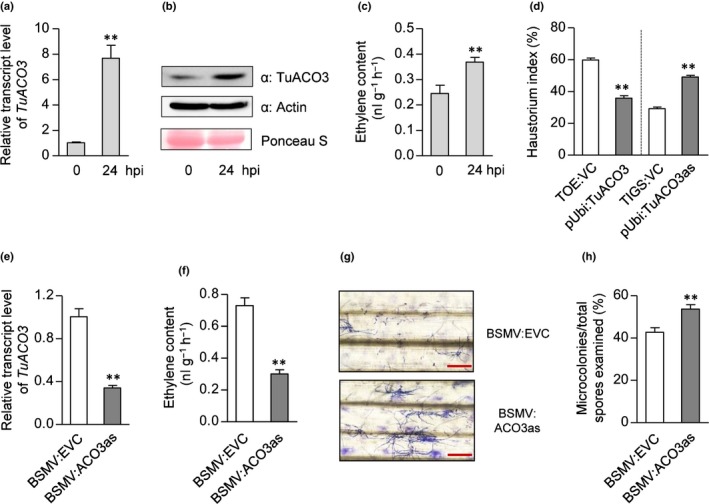Figure 1.

Functional analysis of TuACO3 in the Triticum urartu accession G1812. (a–c) Elevation of TuACO3 expression and ethylene (ET) production at 24 h post‐inoculation (hpi) of Blumeria graminis f.sp. tritici (Bgt). Transcript and protein increases were revealed by quantitative reverse transcription (qRT‐PCR) (a) and immunoblotting with a TuACO3‐specific antibody (b). Detection of actin served as an internal control. Upregulation of ET biosynthesis was determined by gas chromatography analysis (c). (d) Bgt haustorium growth in the leaf cells, suppressed by transiently expressing TuACO3 from the construct pUbi:TuACO3 but stimulated by transiently silencing TuACO3 with the construct pUbi:TuACO3as. TOE:VC and TIGS:VC, empty vector controls for the transient overexpression and silencing assays, respectively. Each mean (± SE) was calculated from the data of three technical repeats (with more than 200 transfected cells examined in each repeat). The results shown were typical of three independent experiments. **, P < 0.01 (Student's t‐test). (e–h) Effects of silencing TuACO3 on Bgt defense and ET production. Silencing was achieved using the recombinant virus BSMV:ACO3as. BSMV:EVC, an empty BSMV vector, served as a control. BSMV:ACO3as lowered the transcript level of TuACO3 (e), decreased ET production (f), and increased the development of Bgt microcolonies as shown by Coomassie blue staining of fungal structures (g) and quantitative comparison with the control (h). The datasets presented each were representative of three independent experiments. Each mean (± SE) was calculated from at least three biological replicates. **, P < 0.01 (Student's t‐test). Bars, 200 μm. ACO, 1‐aminocyclopropane‐1‐carboxylic acid oxidase.
